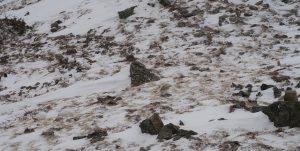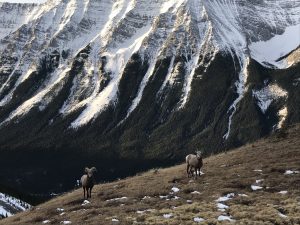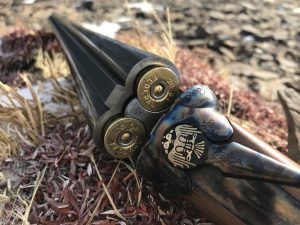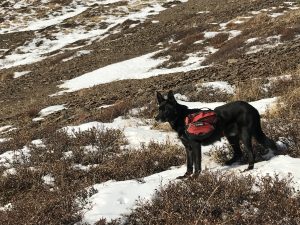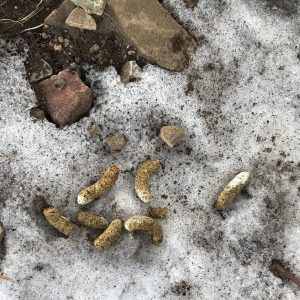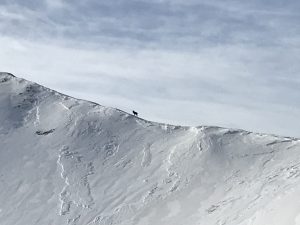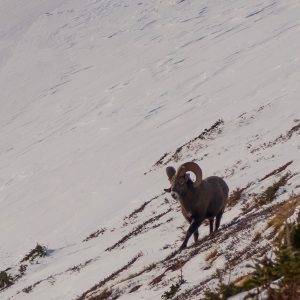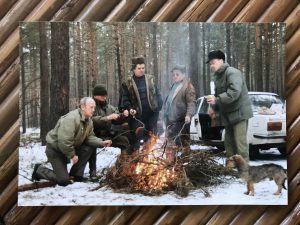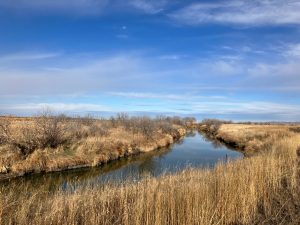
Judging from the departing flocks of pheasants, Finn is somewhere up ahead. Old trees line a meandering ditch, with enough undergrowth to harbour a few dozen birds, apparently. I’m not sure where Bill is, I doubt he’s seeing this bird bonanza. Poor Jack, Bill’s GSP, is trying to work the birds, but Finn has lost his marbles. He busts roosters and hens faster than I can count, and despite a very deliberate forward pace all I can do is watch them sail across the open to a variety of cattail-filled water courses that cut up the stubble fields. Welcome to Montana.
Shortly after returning from Idaho, I received an email from Bill in Missoula, asking if I’d be interested to meet him in Malta, to hunt pheasants for a few days. With some friends he leases the hunting rights on a large Hutterite operation, and only a few of them actually are serious about birds. I consulted the dog, he said “yes”, I consulted my wife, she just smiled and said “go for it”, consulted the boss, he said “sure”, so after a weekend of missing many partridges, destroying what was left of my shooting confidence, we loaded up and drove the four hundred or so miles to a small U-shaped motel in the center of Malta. “Welcome Hunters”. Thank you, happy to be back.
After witnessing Finn’s performance Bill smartens up quickly and suggests we split up for the next act. I’m treated to a repeat performance, with many birds flushing in all directions, without a chance of a shot. Finn is having a fantastic time!
We grab a bite to eat, and hit up some smaller cover on the outskirts of the compound, where it doesn’t take long for Finn to put up a nice rooster, that I manage to bring down with a trepidatious swing of the gun. A few hens followed by a single rooster bust from the cattail-filled ditch a little further down, and only the females escape with their lives. The rooster falls just across the ditch, an easy retrieve for Finn, if not for the icy slush that lies between us and the bird. Finn’s a strong swimmer, and he loves the water, so when he refuses to cross a few times, I take his cues. We’re in for a bit of walk.
Bill and Jack head further up the ditch, while Finn and I double back once we have been able to cross. I don’t doubt his nose, and when we get to where I marked the fallen bird, he pops in and out of the reeds and brings it to hand. Two birds for the day, same for Bill, we head back for a bit of a rest, and an early dinner.
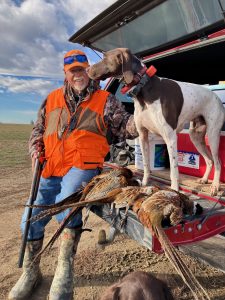
Fewer birds the next day, but what a great place to just walk around, poke through some cover, enjoy the fresh, but not overly cold weather, watch the dogs run, share some stories. We search through an area with high cover, near a hay stock yard, and one rooster manages to fly faster than my pellets. Or I missed.
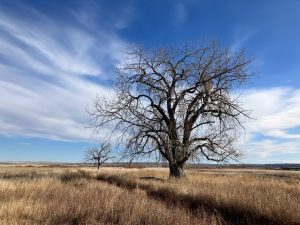
Last night’s rain has made the trails a little slick, and we decide not to range too far onto the farm, and just hunt where we are. As I push through some cattails, I find two stationary dogs, one up against the reeds, the other quite intently looking in his direction. Is Finn honouring Jack’s point? Twenty seconds later Jack finally stops pissing, and walks off. I release Finn, who takes two steps and locks up again.
All it takes is a few tentative steps in his direction for the rooster to explode from minimal cover, headed for the reeds, his raucous cackle adding to the excitement. Somehow I force the gun close enough to the line of flight, and the winged rooster dives for the cattails. Both Finn and Jack take up the task, but the rooster jumps high and evades capture. The melee disappears, and seconds later Finn emerges on the other side. Shame on me, I doubt him, and think about calling him back to have him search where I “know” the bird to be. He proves me wrong, a short pas-de-deux ensues, dog and bird briefly airborne, but two legs and one wing prove no match for four legs and a mouth.
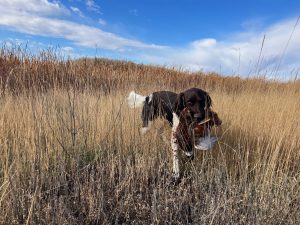
We change restaurants, this one becomes the scene of a fairly dedicated crowd of pool players. The dining room, like that of nearby establishments is filled with what likely are visiting hunters. The motel parking lot is slowly collecting trucks, loaded with empty coolers hoping to be filled. One party is packing up, disappointed by the lack of big bucks, trying their chances elsewhere. “South Eastern Montana”. Hopefully they get lucky there.
We need to hit the road early afternoon on Friday, to make sure they don’t close the border crossing before we are back on Canadian soil, so we stage a few shorter walks. A rooster makes me look like a fool, as I try to drop a snack, close the gun, throw it up, and find the bird. I find both triggers, the second one fires as a result of my finger slipping off the first one. The bird was not really concerned about any of that.
A little later Bill and I both double at a rising rooster. After some discussion we agree that I shot its tail off. With the wind blowing across the cattails, Finn and I follow the ditch. The bird sailed a long way, but we didn’t see it veer off course. More praise on Finn’s head will make it grow out of proportion, but an undetermined time and distance later he takes a hard left into cover, and the splashing brings a surge of hope. Here he comes, casually sauntering over with the live bird in his mouth. A gentle “hold” has him bring it right to hand. I love that dog. When I don’t hate him for running around busting dozens of birds, out of range, that is.
We find a dozen or so more birds, that earlier we pushed into this area from the same tree line as two days before. No luck getting close to them. A little weary we start back to the truck, and attention wavers. Not for Finn, who flushes a pair of sharptails from a shortgrass meadow. The two birds split up, drawing diverging semi-circles through the sky, one high above me, but in range. Temporarily unburdened by doubt, I swing with confidence and drop the bird at my feet.
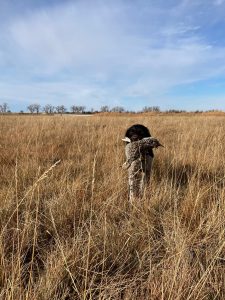
We’re done, time to check the dogs, feed Finn a tailgate dinner, change boots, and fill up the tank. One more ninety-nine cents gas station coffee, a milkshake in Havre, and a jolt up to the border across an empty road. I wonder how the Canadian border guards feel, sitting in the same ramshackle building that they sat in twenty years ago when I first passed through here, while the US has treated their staff to a slightly-megalomaniac border facility, that looks totally out of place here in the middle of nowhere.
Perhaps that is why the guard shows no real interest in probing too deeply, and quickly tells me I have to back out of the chute that led to his window, because the overhead door that blocks my view of Canadian soil doesn’t work. We dash across dark highways, and make good time. Bill graciously offered me his birds, so tomorrow by this time my wife will be asking me when I plan to get rid of all the feathers in the garage.
It’s been a good trip. Maybe we can do it again some day.
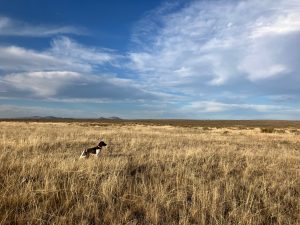
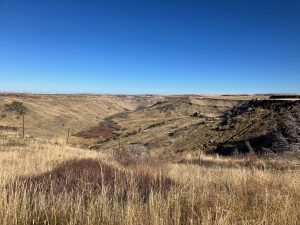
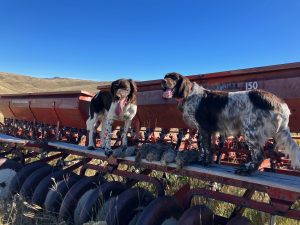
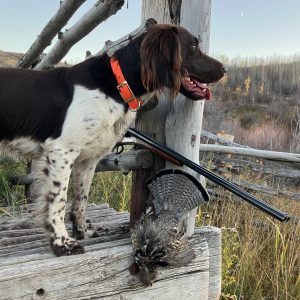
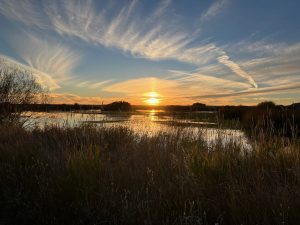
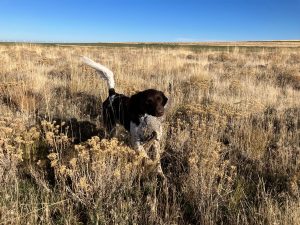
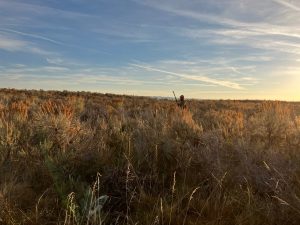
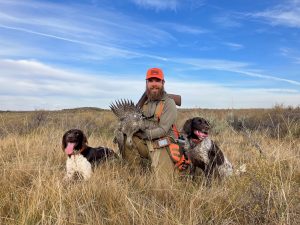
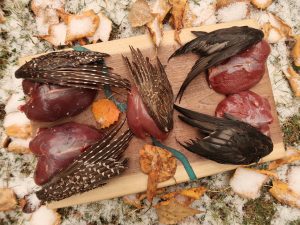
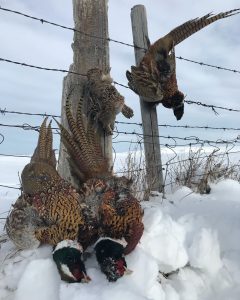
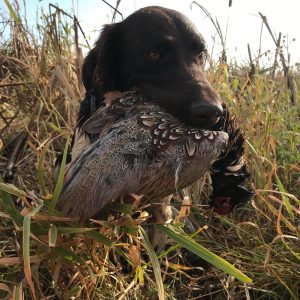
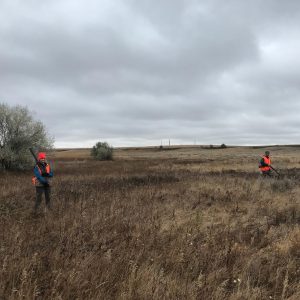
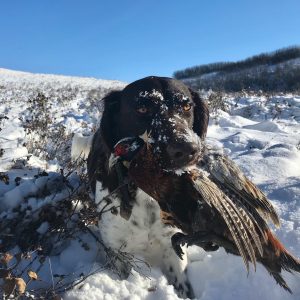
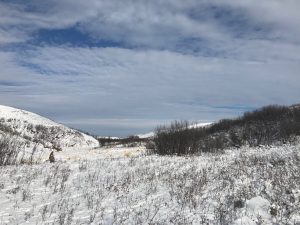
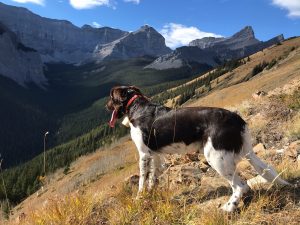
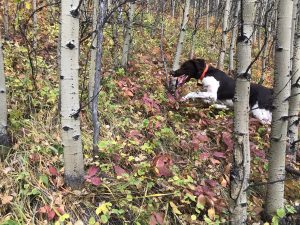
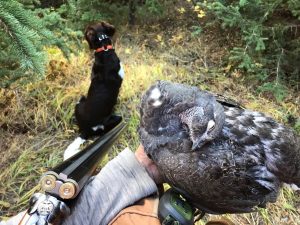
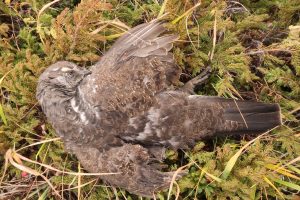
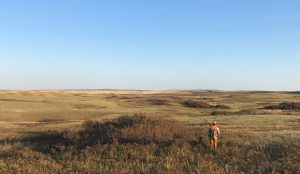
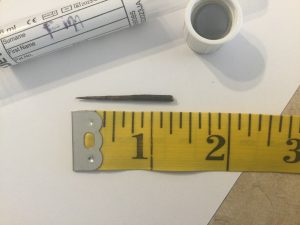
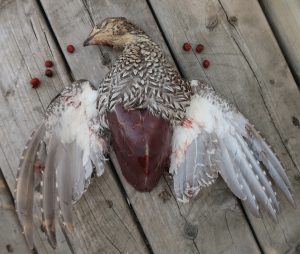
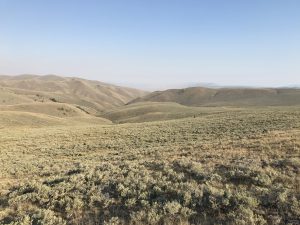
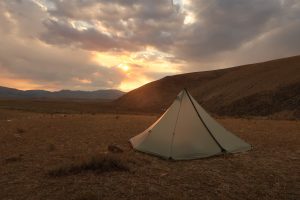
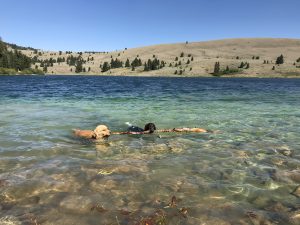 The choice of fields to hunt looked random to me, as for a mile in all directions the terrain was featureless, but it was based on years of experience in this area. I was beginning to pick up small clues about what sage grouse might like. Fresh greens, of which we saw little, grasshoppers, which were ubiquitous, just not in every field. Water perhaps? Some animals get their moisture from plants, but things were pretty arid here. I just imagined birds hitting up water early morning, working their way up to higher areas to catch a breeze, perhaps to return to water late afternoon, before retiring for the night in cover. But that was just speculation.
The choice of fields to hunt looked random to me, as for a mile in all directions the terrain was featureless, but it was based on years of experience in this area. I was beginning to pick up small clues about what sage grouse might like. Fresh greens, of which we saw little, grasshoppers, which were ubiquitous, just not in every field. Water perhaps? Some animals get their moisture from plants, but things were pretty arid here. I just imagined birds hitting up water early morning, working their way up to higher areas to catch a breeze, perhaps to return to water late afternoon, before retiring for the night in cover. But that was just speculation.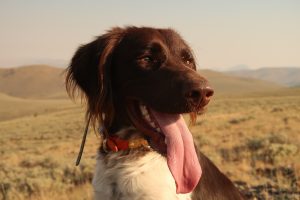
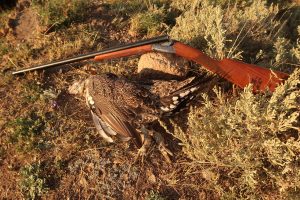 The second morning was mostly a repeat of the first. We hunted a large swath of land, in semi-circular fashion, above a small water source. My friend connected first, missing birds in a covey, but then connecting with the third shot on a single. Finn was bullied out of the retrieve by the other dog, but he got another chance. First a pair of grouse were bumped out of range by my friend’s dog, but not much later I shot a single with the second barrel, as it was rocketing down and around the slope. Finn nicely
The second morning was mostly a repeat of the first. We hunted a large swath of land, in semi-circular fashion, above a small water source. My friend connected first, missing birds in a covey, but then connecting with the third shot on a single. Finn was bullied out of the retrieve by the other dog, but he got another chance. First a pair of grouse were bumped out of range by my friend’s dog, but not much later I shot a single with the second barrel, as it was rocketing down and around the slope. Finn nicely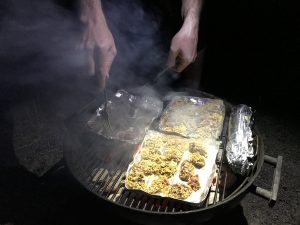 At night, my friend’s son cooked us up a nice meal of cubed, breaded grouse breast, and cutthroat trout. A few cold beers went with that, and life could not have been much better.
At night, my friend’s son cooked us up a nice meal of cubed, breaded grouse breast, and cutthroat trout. A few cold beers went with that, and life could not have been much better.